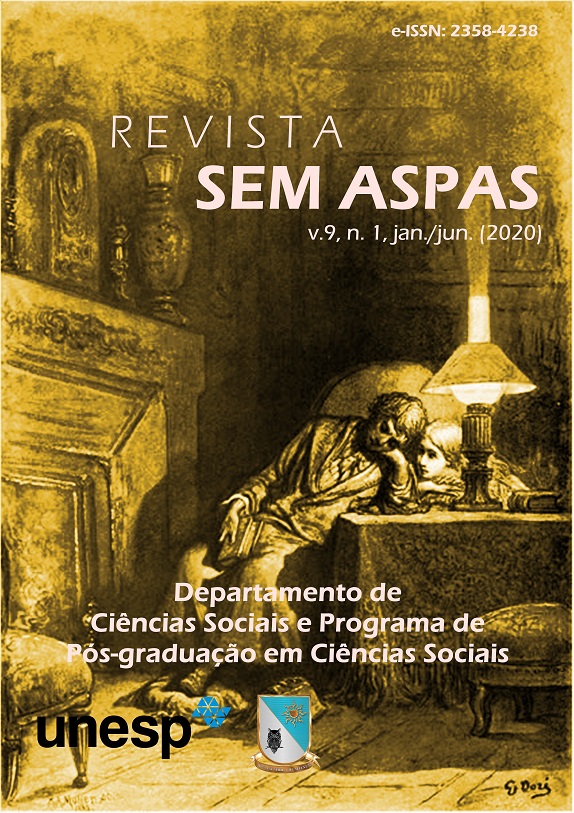Reflections about women's body and sexuality in eastern dance: comparatives between Brazil-Egypt under foucaultian optics
DOI:
https://doi.org/10.29373/sas.v9i1.14268Keywords:
Body, Dance, Power, Sexuality.Abstract
Art is classified through the ages, from the most remote, in the most distinct artistic characteristics, as a way of looking at the world. Among the most appreciated arts, the art of dance, present since the earliest civilizations, endures in modern times, enchanting generations. Through dance, whatever the style, one speaks, writes, draws, dreams, utilizing the body. The art of dance enhances bodily experiences in different social organizations. Its importance is in force in every epoch of history and is so unique that it changes and changes, and has been present since the earliest civilizations. The aim is to give the subject the opportunity in the field of sensitivities, based on dance, allowing him to experience a cognitive / affective experience, providing disruption in the way of reading / thinking and acting, about himself, the other and the world in an ethical and reflective way. In this way, the referring qualitative research sought to analyze the similarities and differences of the woman's body and sexuality in oriental dance in Brazil and Egypt through thematic analysis. The expected results signal an improvement in the ways of dancing in a pleasurable and critical way with greater emotional involvement, signaling the creation of an environment of spontaneity and creativity, allowing it to immerse itself in body language, enabling the construction and reconstruction of the gaze, the stimulation of the body. imagination, self-affirmation and autonomy, in addition to getting used to the existence of coexistence of form. In this sense, art can be innovative as it unfolds into a life project, in the (re) construction of new subjectivities impacting new modes of existence.
Downloads
References
BRASIL. Lei n. 8.313, de 23 de dezembro de 1991. Lei Federal de Incentivo à Cultura. Restabelece princípios da Lei n. 7.505, de 2 de julho de 1986, institui o Programa Nacional de Apoio à Cultura (Pronac) e dá outras providências. Brasília, 24 dez. 1991. Disponível em: http://www.planalto.gov.br/ccivil_03/leis/l8313cons.htm. Acesso em: 12 de fev. 2018.
BULFINCH, T. O livro de ouro da mitologia: história de deuses e heróis. Trad. David Jardim Jr. Rio de Janeiro: Ediouro Publicações, 2002.
CHARAUDEAU, P. Discurso das mídias. São Paulo: Editora Contexto, 2006.
CORBAIN, A.; COURTINE, J.; VIGARELLO, G. História do corpo: da renascença às luzes. Rio de Janeiro: Editora Vozes, 2008.
DELEUZE, G. A imagem-movimento. Trad. Stella Senra. São Paulo: Editora Brasiliense, 1983.
DELEUZE, G.; GUATTARI, F. Mil platôs. Trad. Peter Pál Pelbart e Janice Caiafa. São Paulo: Editora 34, 2017.
DOURADO, H. A. Dicionário de termos e expressões da música. São Paulo: Ed. 34, 2004.
FOUCAULT, M. História da sexualidade 1: a vontade de saber. Trad. Maria Thereza da Costa Albuquerque. São Paulo: Editora Paz e Terra, 2013.
FOUCAULT, M. História da sexualidade 3: o cuidado de si. Trad. Maria Thereza da Costa Albuquerque. São Paulo: Editora Paz e Terra, 2013.
FOUCAULT, M. Vigiar e punir: nascimento da prisão; tradução de Raquel Ramalhete. Petrópolis: Vozes, 1987.
FURLANI, J. Educação sexual na sala de aula: relações de gênero, orientação sexual e igualdade étnico-racial numa proposta de respeito às diferenças. Belo Horizonte: Autêntica Editora, 2016.
GIFFONI, M. A. C. Danças da Ásia, África e Oceania. São Paulo: Nobel, 1974.
GOMBRICH, E. H. A história da arte. Rio de Janeiro: LTC, 2000.
GREGOLIN, M. R. V. Análise do discurso: os sentidos e suas movências. In: GREGOLIN, M. R. V. et al. (org.). Análise do discurso: entornos do sentido. Araraquara: UNESP, Laboratório Editorial; São Paulo: Cultura Acadêmica Editora, 2001.
MAINGUENEAU, D. Discurso e análise do discurso. Trad. Sírio Possenti. São Paulo: Parábola Editorial, 2015.
MICHAELIS. Dicionário de Língua Portuguesa. 2009. Disponível em: http://michaelis.uol.com.br/. Acesso em: 12 de fev. 2018.
MIEL, L. Borbulhas de dança: mundo encantado, estranhos prazeres, profundos conflitos. Santa Catarina: Clube de Autores, 2019.
ORLANDI, E. P. Discurso em Análise: Sujeito, Sentido, Ideologia. Campinas: Pontes, 2012.
SHARKEY, S. Resgatando a feminilidade: expressão e consciência corporal pela dança do ventre. São Paulo: Scortecci Editora, 2002.
TRAUNECKER, C. Os deuses do Egito. Brasília: Editora Universidade de Brasília, 1995.
VIANNA, K. A dança. São Paulo: Summus Editorial, 2005.
Downloads
Published
How to Cite
Issue
Section
License
Copyright (c) 2020 Revista Sem Aspas

This work is licensed under a Creative Commons Attribution-NonCommercial-NoDerivatives 4.0 International License.
Os manuscritos aceitos e publicados são de propriedade da Sem Aspas. Os artigos publicados e as referências citadas na revista Sem Aspas são de inteira responsabilidade de seus autores.








